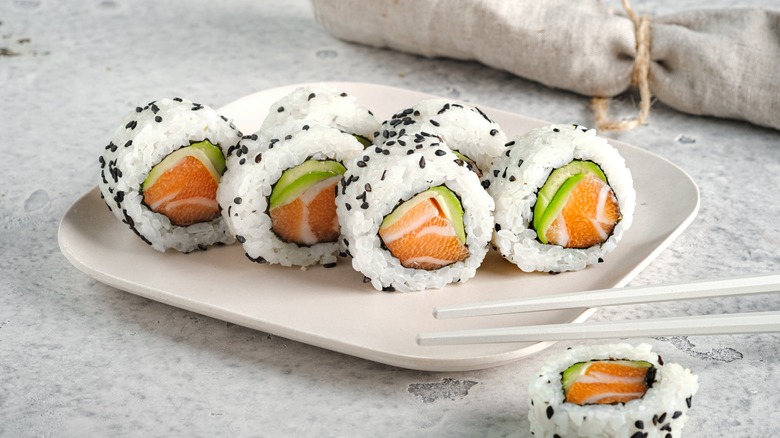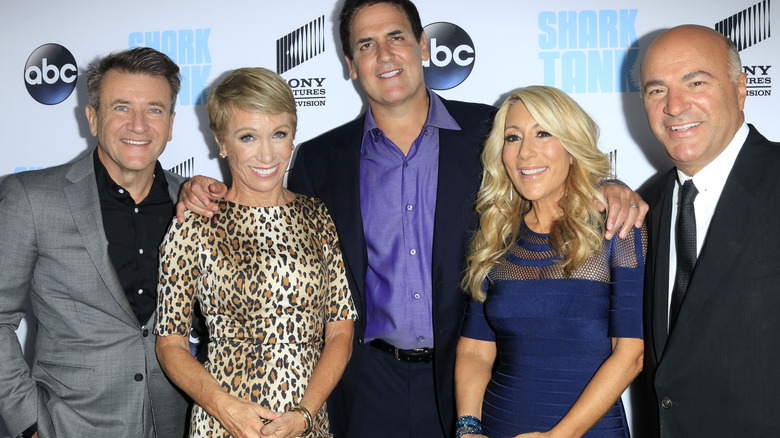Where Is How Do You Roll From Shark Tank Today?
Americans may be getting familiar with the six different types of sushi, but it's not something we'd normally make for ourselves. Finding sushi-quality fish is tough for many home cooks, rolling or forming rice is a specialized technique, and the knife skills required are pretty advanced. So, we go out for sushi and let the experts handle it. In 2022, Americans spent almost $25 billion dollars on sushi, a number that has been on a steady incline for at least the past decade (per Statista).
You may be surprised to learn that sushi in America is still pretty new., in fact, American sushi didn't take root until the late 1960s. While the Japanese Sushi tradition is all about simplicity — well-cooked, perfectly seasoned rice, with pristine, fresh fish — Americans had hang-ups about eating raw fish and seaweed. It seems more textures, sauce, cooked toppings, and fillings were demanded. That, and tuna being tough to find, led to a new kind of sushi, like the California Roll, which subs king crab, avocado, and cream cheese for fatty tuna.
Since sushi became popularized in America, we have enjoyed it dining in restaurants and for take-out. And the brazen few may grab pre-made packaged sushi at the supermarket as it's inexpensive, convenient, and if made on the premises, pretty good.
How Do You Roll enters the Tank
Brothers Yeun and Peter Yung wanted to find the happy medium between the two extremes of sushi dining. Their fast-casual restaurant, How Do You Roll, aimed to do just that. Customers approach the counter and go through a four-step process to create their own, customized roll. It's something like Chipotle for sushi where they "allow the customer to become the chef."
You can watch them ask the sharks for a $1 million investment and a 12% stake in their expansion plan on Hulu. The plan? To be come "the next great thing in ethnic food." At this point, they have two restaurants, and 40 franchises, 15 of which are already open in Texas, California, and Arizona. It's a restaurant concept on the upswing.
Barbara Corcoran gets an opportunity to run through the process of making a customized roll, and she, along with all the sharks, loves it. However, restaurants are tricky enough without the added difficulties of fresh sushi. So, Mark Cuban is out. Ditto for Daymond John, who can't stomach the low-margins. Robert Herjavec is afraid of the large ask and his lack of familiarity with this business. Barbara Corcoran's gut instinct is to be out, too.
That only leaves Kevin O'Leary who is familiar with the real estate struggles of franchising a business. That knowledge is exactly what they need. So, they accept his million-dollar offer for 20% and a portion of franchise royalties.
How Do You Roll didn't fare well after the show
The agreement with O'Leary, which Corcoran warned could be a "deal with the devil," never panned out. As is the case of most on-screen "Shark Tank" deals, the details hashed out after an on-screen handshake often lead some deals to die before coming to fruition.
The Yung brothers had other investment opportunities, which they mentioned while in front of the sharks, but it's unclear if those deals were made either. However, what is clear as far as we can see is that How Do You Roll is no longer rolling. None of the restaurants appear to be open for business. Its website is down, and all social media accounts have gone dark since a final Tweet in 2016. If you were a fan, maybe you've had to learn to master your own spicy tuna roll recipe.
How Do You Roll was sprung from the Yung brothers Maki-Maki, LLC. Dun & Bradstreet lists that LLC's address at a former How Do You Roll location in Austin. Texas. That same Dun & Bradstreet listing cites a new website that links to a single-location sushi restaurant in Austin. But, that restaurant doesn't have any clear connection to either of the founders of How Do You Roll.


